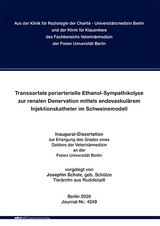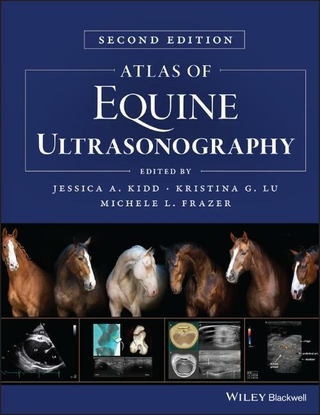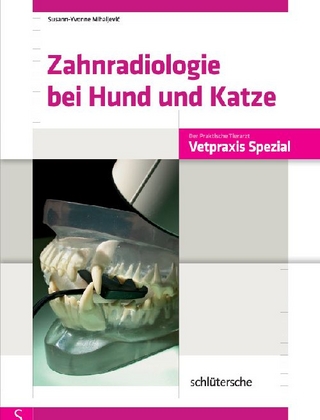Transaortale periarterielle Ethanol-Sympathikolyse zur renalen Denervation mittels endovaskulärem Injektionskatheter im Schweinemodell
Seiten
2021
|
1. Aufl.
Mensch & Buch (Verlag)
978-3-96729-098-1 (ISBN)
Mensch & Buch (Verlag)
978-3-96729-098-1 (ISBN)
- Keine Verlagsinformationen verfügbar
- Artikel merken
Bluthochdruckpatienten haben ein deutlich erhöhtes Risiko einen Schlaganfall oder Herzinfarkt zu erleiden. Aber auch andere Endorgane wie die Nieren oder die Augen können durch den langanhaltend erhöhten Blutdruck schwerwiegende Schäden davon tragen. Seit den 50er Jahren stehen als Therapie sehr potente orale Medikamente zur Verfügung. Jedoch sind bis zu einem Drittel der Menschen mit arterieller Hypertonie therapierefraktär. Für diese Patientengruppe ist es dringend notwendig, dass neue effektive und sichere Therapieansätze entwickelt werden. In den letzten Jahren hat man daher das Konzept der renalen Denervierung wieder entdeckt und mit den neuen minimalinvasiven Techniken weiterentwickelt. Sie basiert auf dem Hintergrundwissen, dass die sympathischen Nervenfasern, welche periarteriell in der Adventitia der Nierenarterie verlaufen, maßgeblich an der Regulation des Blutdrucks beteiligt sind. Diese so zu schädigen, dass sie ihre Funktion verlieren, ist das Ziel der renalen sympathischen Denervation. 2009 schien man mit der Einführung des Symplicity-Katheters dieses Ziel erreicht zu haben. Dieser Katheter wird über einen femoralen Zugang bis in die Nierenarterie vorgeschoben um mittels einer Elektrode punktuell Radiofrequenzenergie an das umliegende Gewebe abzugeben. So werden die dort verlaufenden Nerven durch die Wärmeentwicklung deaktiviert. Die Symplicity HTN-3-Studie, welche erstmals randomisiert und verblindet war, konnte keine überzeugenden Ergebnisse hinsichtlich der Effektivität des Verfahrens liefern. Daher folgten diverse Studien, um neue Methoden zur renalen Denervierung zu erproben. Neben den thermischen Verfahren wie die RFA oder HIFU, ist auch die Verwendung neurotoxischer Substanzen erfolgreich in präklinischen sowie klinischen Studien getestet worden.
Aus anatomischen Gründen sind jedoch nicht alle refraktären Hypertoniker für den Einsatz des Symplicity-Katheters geeignet. Die Nierenarterie muss für diesen Eingriff z. B. eine vorgeschriebene Größe und Länge aufweisen. Zudem sind auch bestimmte Vorerkrankungen der Nierenarterien ein Ausschlusskriterium. Um diese Limitationen der Nierenarterie zu umgehen und den potentiellen zukünftigen Patientenkreis zu erweitern, untersuchten wir in dieser Arbeit einen neuartigen Zugangsweg zur Applikation der neurotoxischen Substanz. Ziel dieser Arbeit war es die Machbarkeit der renalen Denervation mittels katheterbasierter transaortaler Ethanolapplikation im Schweinemodell zu evaluieren. Dafür wurden 11 normotensive Tiere in Allgemeinnarkose behandelt. Über die A. femoralis wurde unter Fluoroskopie ein Katheter mit steuerbarer Spitze und einer experimentellen ein- und ausfahrbaren Injektionsnadel bis in die Aorta vorgeführt. Nach Penetration der Aortenwand knapp oberhalb des Ostium renalis wurde ein Gemisch aus Kontrastmittel, Lokalanästhetikum und Ethanol injiziert. Die unbehandelte Seite diente als Kontrolle. Nach 4 Wochen Standzeit wurden die Tiere euthanasiert und der NA-Gehalt im Nierenparenchym gemessen, sowie die Nierenarterie und ihre umliegenden Strukturen histologisch untersucht. Außerdem wurde der Blutdruck unmittelbar vor und nach der Intervention sowie am Tag der Euthanasie nicht invasiv am narkotisierten Tier gemessen.
Zusammenfassend kann man sagen, dass das Verfahren bei 10 von 11 Tieren technisch durchführbar war. Ein Tier verstarb aufgrund von Kreislaufversagen in der Aufwachphase, was aber nicht in Verbindung mit der Intervention zu sehen ist. Bei einem anderen Tier kam es infolge einer versehentlichen intraarteriellen Ethanolinjektion zur Thrombosierung und Infarzierung der behandelten Niere. Bei 3 Schweinen ist das Injektat auch auf die kontralaterale Seite geflossen. Betrachtet man die technisch optimal durchgeführten Eingriffe, gab es einen messbaren NA-Abfall auf der behandelten Seite, jedoch war dieser nicht signifikant. Histologisch waren auf der behandelten Seite deutlich degenerierte Nerven nachweisbar. Der Blutdruck hat sich, wie bei einer einseitigen Denervation zu erwarten war, über die Zeit nicht verändert. Es sind weitere Studien nötig, um festzustellen ob die Ethanolinjektion über einen transaortalen Zugang eine Alternative zu der perkutanen oder transarteriellen Applikation darstellen kann. Renal denervation by transaortic periarterial ethanol injection: an experimental study in porcines
Arterial hypertension is a serious world wide health problem. Hypertension is a major risk factor for cardiovascular morbidity and mortality like stroke or heart failure. Furthermore it increases the risk for the progression of chronic kidney disease and vision loss. Life style changes and oral medications are prescriped to lower the blood pressure < 140/90 mmHg. Unfortunately there are estimated 10 - 30 % of patients whose blood pressure is uncontrolled despite taking antihypertensive drugs. Such therapy-resistant hypertension is defined as high blood pressure > 140/90 mmHg in spite of taking 3 or more antihypertensive agents at optimal dose, with at least one beeing a diuretic. To find a safe and effective therapy for people with resistant hypertension is essential because of the severe consequences of this illness. The concept of renal denervation with minimal invasive techniques seems a viable option since 2009. The backround is the knowledge of the sympathetic nervous system and its effect on blood pressure regulation in the body. To destroy the afferent and efferent nerves laying in the adventitial space around the renal arteries is the aim of renal denervation. 2010 the first study of the Simplicity catheter was published and seemed promising. A catheter applies radiofrequency energy to the intima of the renal artery. Multiple ablations lead to severe sympathetic nerve damage and drop of blood pressure. 2014 this system suffered a major set back with puplishing the disappointing results of the HTN-3 trial. So scientists were looking for different catheter and non-catheter-based methods to accomplish renal denervation. Next to heat, cold and ultrasound the use of neurotoxic substances seemed promising. Especially ethanol was sucessfully used in preclinical animal studies.
Using the Symplicity-catheter inside the renal artery has several anatomical limitations like the length and the diameter of the vessel. To bypass these limitations we are using a new access path to inject the ethanol. This might help to broaden the spectrum of future patients. The aim of this study is to evaluate the safety, feasibility and efficancy of endoluminal transaortal ethanol injektion to denervate renal sympathetic nerves in a porcine model. 11 normotensive pigs underwent general anesthesia. A 7 F steerable sheath was inserted via the femoral arteria and advanced within in the aorta. Then the tip was flexed so it was pointed against the aortal wall just above the origin oft he renal artery. An experimental 21 G needle with an extandable and retractable tip punctured the aortic wall and injected the ethanol into the periarterial space of the renal artery. After 4 weeks the pigs were euthanized and the norepinephrine concentration in the renal parenchyma was determined. Furthermore the renal arteries and the sourrounding tissue were pathohistologically examined to find potential nerve damage. The blood pressure was messured noninvasively straight before and after the procedure as well as after 4 weeks on the day of euthanasia.
Our findings were that in 10 of 11 pigs the intervention was technical successfully feasible. One pig got a major complication since a little amount of the ethanol got injected into the renal artery. It caused formation of a thrombus and subsequent infarction of the kidney. Pig 4 died of cardiac arrest while waking up from anesthesia not related to the intervention. Within 3 animals the ethanol mixture ran also onto the contralateral side.
Looking at the optimal treated pigs the efficiency was shown by the nerve damage found histologically on the treated side. While the norepinephrine concentration was lower on the treated side, the difference was not significantly. Further preclinical and clinical studies are necessary to discuss whether the transaortic ethanol injection is a reasonable alternative to the percutan or transarterial approach.
Aus anatomischen Gründen sind jedoch nicht alle refraktären Hypertoniker für den Einsatz des Symplicity-Katheters geeignet. Die Nierenarterie muss für diesen Eingriff z. B. eine vorgeschriebene Größe und Länge aufweisen. Zudem sind auch bestimmte Vorerkrankungen der Nierenarterien ein Ausschlusskriterium. Um diese Limitationen der Nierenarterie zu umgehen und den potentiellen zukünftigen Patientenkreis zu erweitern, untersuchten wir in dieser Arbeit einen neuartigen Zugangsweg zur Applikation der neurotoxischen Substanz. Ziel dieser Arbeit war es die Machbarkeit der renalen Denervation mittels katheterbasierter transaortaler Ethanolapplikation im Schweinemodell zu evaluieren. Dafür wurden 11 normotensive Tiere in Allgemeinnarkose behandelt. Über die A. femoralis wurde unter Fluoroskopie ein Katheter mit steuerbarer Spitze und einer experimentellen ein- und ausfahrbaren Injektionsnadel bis in die Aorta vorgeführt. Nach Penetration der Aortenwand knapp oberhalb des Ostium renalis wurde ein Gemisch aus Kontrastmittel, Lokalanästhetikum und Ethanol injiziert. Die unbehandelte Seite diente als Kontrolle. Nach 4 Wochen Standzeit wurden die Tiere euthanasiert und der NA-Gehalt im Nierenparenchym gemessen, sowie die Nierenarterie und ihre umliegenden Strukturen histologisch untersucht. Außerdem wurde der Blutdruck unmittelbar vor und nach der Intervention sowie am Tag der Euthanasie nicht invasiv am narkotisierten Tier gemessen.
Zusammenfassend kann man sagen, dass das Verfahren bei 10 von 11 Tieren technisch durchführbar war. Ein Tier verstarb aufgrund von Kreislaufversagen in der Aufwachphase, was aber nicht in Verbindung mit der Intervention zu sehen ist. Bei einem anderen Tier kam es infolge einer versehentlichen intraarteriellen Ethanolinjektion zur Thrombosierung und Infarzierung der behandelten Niere. Bei 3 Schweinen ist das Injektat auch auf die kontralaterale Seite geflossen. Betrachtet man die technisch optimal durchgeführten Eingriffe, gab es einen messbaren NA-Abfall auf der behandelten Seite, jedoch war dieser nicht signifikant. Histologisch waren auf der behandelten Seite deutlich degenerierte Nerven nachweisbar. Der Blutdruck hat sich, wie bei einer einseitigen Denervation zu erwarten war, über die Zeit nicht verändert. Es sind weitere Studien nötig, um festzustellen ob die Ethanolinjektion über einen transaortalen Zugang eine Alternative zu der perkutanen oder transarteriellen Applikation darstellen kann. Renal denervation by transaortic periarterial ethanol injection: an experimental study in porcines
Arterial hypertension is a serious world wide health problem. Hypertension is a major risk factor for cardiovascular morbidity and mortality like stroke or heart failure. Furthermore it increases the risk for the progression of chronic kidney disease and vision loss. Life style changes and oral medications are prescriped to lower the blood pressure < 140/90 mmHg. Unfortunately there are estimated 10 - 30 % of patients whose blood pressure is uncontrolled despite taking antihypertensive drugs. Such therapy-resistant hypertension is defined as high blood pressure > 140/90 mmHg in spite of taking 3 or more antihypertensive agents at optimal dose, with at least one beeing a diuretic. To find a safe and effective therapy for people with resistant hypertension is essential because of the severe consequences of this illness. The concept of renal denervation with minimal invasive techniques seems a viable option since 2009. The backround is the knowledge of the sympathetic nervous system and its effect on blood pressure regulation in the body. To destroy the afferent and efferent nerves laying in the adventitial space around the renal arteries is the aim of renal denervation. 2010 the first study of the Simplicity catheter was published and seemed promising. A catheter applies radiofrequency energy to the intima of the renal artery. Multiple ablations lead to severe sympathetic nerve damage and drop of blood pressure. 2014 this system suffered a major set back with puplishing the disappointing results of the HTN-3 trial. So scientists were looking for different catheter and non-catheter-based methods to accomplish renal denervation. Next to heat, cold and ultrasound the use of neurotoxic substances seemed promising. Especially ethanol was sucessfully used in preclinical animal studies.
Using the Symplicity-catheter inside the renal artery has several anatomical limitations like the length and the diameter of the vessel. To bypass these limitations we are using a new access path to inject the ethanol. This might help to broaden the spectrum of future patients. The aim of this study is to evaluate the safety, feasibility and efficancy of endoluminal transaortal ethanol injektion to denervate renal sympathetic nerves in a porcine model. 11 normotensive pigs underwent general anesthesia. A 7 F steerable sheath was inserted via the femoral arteria and advanced within in the aorta. Then the tip was flexed so it was pointed against the aortal wall just above the origin oft he renal artery. An experimental 21 G needle with an extandable and retractable tip punctured the aortic wall and injected the ethanol into the periarterial space of the renal artery. After 4 weeks the pigs were euthanized and the norepinephrine concentration in the renal parenchyma was determined. Furthermore the renal arteries and the sourrounding tissue were pathohistologically examined to find potential nerve damage. The blood pressure was messured noninvasively straight before and after the procedure as well as after 4 weeks on the day of euthanasia.
Our findings were that in 10 of 11 pigs the intervention was technical successfully feasible. One pig got a major complication since a little amount of the ethanol got injected into the renal artery. It caused formation of a thrombus and subsequent infarction of the kidney. Pig 4 died of cardiac arrest while waking up from anesthesia not related to the intervention. Within 3 animals the ethanol mixture ran also onto the contralateral side.
Looking at the optimal treated pigs the efficiency was shown by the nerve damage found histologically on the treated side. While the norepinephrine concentration was lower on the treated side, the difference was not significantly. Further preclinical and clinical studies are necessary to discuss whether the transaortic ethanol injection is a reasonable alternative to the percutan or transarterial approach.
| Erscheinungsdatum | 09.06.2021 |
|---|---|
| Verlagsort | Berlin |
| Sprache | deutsch |
| Maße | 148 x 210 mm |
| Themenwelt | Veterinärmedizin ► Allgemein |
| Veterinärmedizin ► Klinische Fächer ► Bildgebende Verfahren | |
| Schlagworte | Animal Models • catheters • Denervation • Ethanol • Histologie • Histology • Injection • Injektion • Katheter • kidney • Niere • Nierenfunktionen • norepinephrin • norepinephrine • Pigs • renal functions • Schweine • sympatholytics • Sympatholytika • Tiermodelle |
| ISBN-10 | 3-96729-098-0 / 3967290980 |
| ISBN-13 | 978-3-96729-098-1 / 9783967290981 |
| Zustand | Neuware |
| Informationen gemäß Produktsicherheitsverordnung (GPSR) | |
| Haben Sie eine Frage zum Produkt? |
Mehr entdecken
aus dem Bereich
aus dem Bereich
Buch | Hardcover (2021)
Wiley-Blackwell (Verlag)
169,00 €




